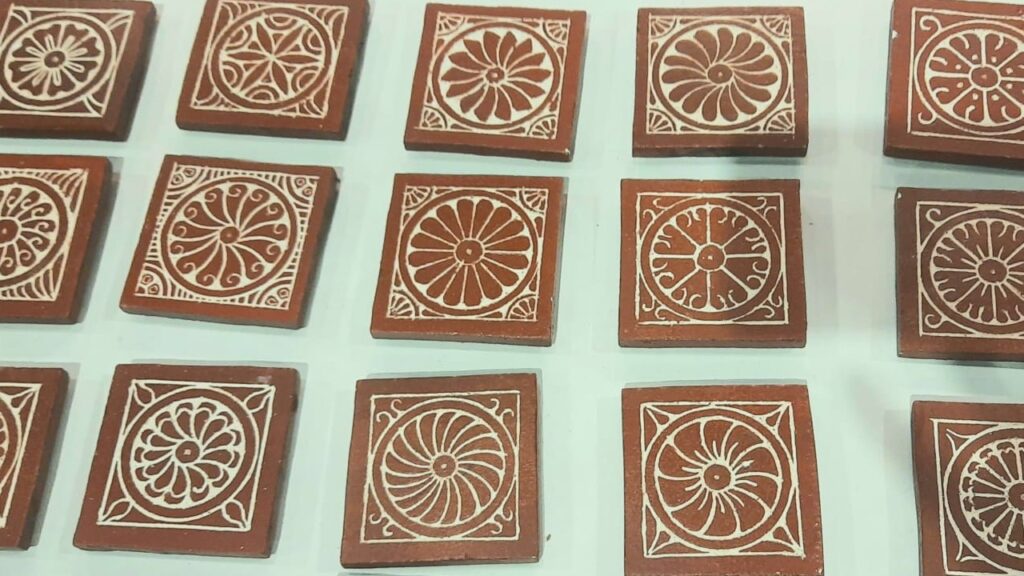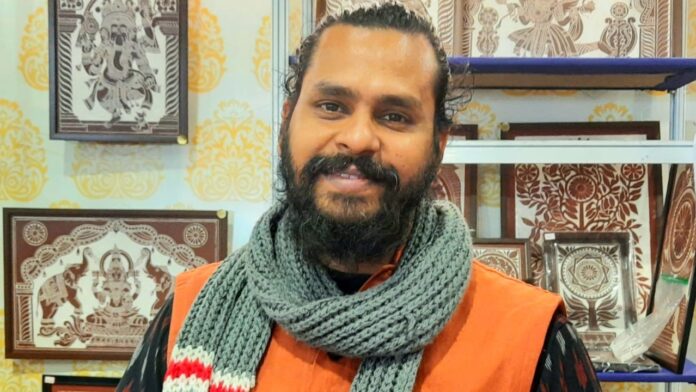Embark on a captivating visual journey as we explore the ancient artistry of Kaavi Art, flourishing along the enchanting coastlines of Goa, Karnataka, and Maharashtra in India. This unique tradition, utilizing ‘Kemmannu’ (red soil) and ‘Chippi Sunna’ (Lime), embellishes historic structures with intricate patterns, mandala compositions, and narrative panels featuring mythological and contemporary figures.
Moreover, this art form weaves a rich tapestry of diversity, manifesting itself uniquely in Hindu, Christian, Jain, Muslim, and various architectural structures. It was once a prevalent artistic expression within the architectural wonders of the Konkan coastal regions, reflecting a harmonious convergence of diverse cultural and religious influences. However, the art form faced a precarious fate with the advent of modern construction methods.
Revived through the dedicated efforts of Dr. Janardhan Rao Havanje over two decades, ‘Kaavi Art’ is also now experiencing a renaissance. It graces numerous homes, temples, and architectural wonders.
The ‘Kaavi Art, Havanje’ foundation, led by Dr. Janardhan Rao Havanje, actively conducts workshops, conserves ancient structures, and leverages modern media to propel this rich legacy forward. It’s important now to preserve and nurture this exquisite art form—a cultural odyssey seamlessly blending heritage and modernity.
In an exclusive interaction with The Interview World, Dr. Janardhan Rao Havanje shares insights into how Kaavi Art is spreading its wings and reaching out to the world at large. Here are excerpts from his enlightening interview.
Q: Tell us about your art form.
A: I specialize in Kaavi Art, a unique form that dates back to the 13th century and has unfortunately faded over time. You can find this distinctive art along the Konkan coast, spanning through Goa, Karnataka, and Maharashtra, encompassing the entire west coast of India.
Kaavi Art once adorned various structures including temples, houses, churches, and mosques throughout the west coast. However, with the advent of cement, this exquisite art form witnessed a gradual decay. Now, it is almost on the verge of extinction. Over the past two decades, my colleagues and I have dedicated ourselves to reviving and elevating this ancient form.
Being an indigenous artist, I pursued a PhD in the same field at Manipal University. Currently, I serve as a professor in an architecture college, where I impart knowledge about this unique art form. Our primary mission is to raise awareness and foster the promotion of Kaavi Art.
Q: What kind of materials do you use to create this art form?
A: We employ a combination of shell, lime, and red soil, creating a distinctive art form that transcends traditional painting techniques. Instead of merely applying paint, we etch our designs onto surfaces, showcasing a unique craftsmanship. Moreover, we meticulously craft the intricate geometrical patterns using tools like dividers and compasses, highlighting the precision involved.
Stencils are merely one aspect of designing. Furthermore, our approach involves freehand crafting, adding an artistic touch to every creation. Our process revolves around the use of natural ingredients such as soil, lime, jaggery, creeper glue, fruit glue, and tree glue. We thoughtfully combine these materials depending on their availability. Eventually, it results in a harmonious blend that encapsulates the magic of skills. Finally, we etch the design, culminating in a one-of-a-kind piece of art.
Q: Have you applied this art form in modern structures?
A: Yes, we undertake numerous projects. One notable example reflects our work at Mangalore International Airport. At the Airport, you can witness our distinctive caveat panels. In a specific section, these panels even replaced traditional ceiling panels, showcasing their versatility. Beyond airport projects, we also execute temple and house projects for the past 15-20 years.
It’s worth noting that the unique art form we specialize doesn’t have global recognition. However, it has gained prominence in the Konkan belt. We take pride in our efforts to raise awareness, conducting workshops in government schools to share this exceptional cultural tradition.
Q: What stories do you engrave in this art form?
A: We specialize in portraying epic narratives, including stories like the Ramayana and Mahabharata, as well as various Puranic tales. Our artistic expressions also encompass a wide range of deities, featuring representations of Digpalakas, Vedic Gods, and more. Drawing inspiration primarily from Shastras and Dhyana Shlokas, we strive to capture the essence of these timeless narratives.
While our foundation lies in traditional subjects, we also explore contemporary themes, incorporating figures from the modern era. As a contemporary artist myself, I hold a master’s degree in painting, which fuels my dedication to honing my craft. This academic background has contributed to the refinement of my artistic skills.
One notable achievement in my artistic journey is the selection of my Kaavi art piece titled “Village Life” for the Biennale exhibition. This international art showcase, hosted in the UK, provided me recognition on a global scale.
Q: What is the life of this art form?
A: Typically, this artistic technique involves adorning walls, and remarkably, its longevity can extend beyond 600 years, thanks to the application of the buon fresco method. Specifically, when implemented on lime-based foundations, it can endure for an impressive 50 to 60 years.
To initiate the process, we normally prepare a lime block meticulously. This serves as the groundwork upon which we apply various gluten materials. The addition of a synthetic substance enhances the block’s structural integrity, followed by the application of red soil sourced from a laterite quarry. We also incorporate quality mud, subjected to rigorous testing, into the mixture.
Moreover, the concoction involves a blend of jaggery and additional gluten materials. We skillfully apply to the surface. Notably, we involve this application on the wet surface, allowing for intricate etching.
Q: How many artisans have practiced this art form after your efforts?
A: For the past 15 years, I’ve been imparting training in this particular art form. Over a hundred skilled artisans are practicing and refining their craft within this discipline. Among them, 14 artists collaborate directly with me. Our work involves numerous projects, each undertaken with a daily payment structure. Notably, I handle approximately 80% of the overall workload. This primarily involves experimental approaches, drawing from the insights documented in my thesis.
Q: What is the economic viability of Kaavi Art?
A: Engaging in this art form can lead to a fulfilling life. However, it’s noteworthy that individuals who are locals in a particular region enjoy distinct advantages. Nonetheless, it is essential to emphasize that people from other regions should also embrace and study this art form. Providing the “Gl” tag, or recognition, to those practicing or residing in the specific locality is crucial. The collective involvement of diverse individuals contributes to the enhancement of the art form’s standards. This is because they gain a deeper understanding of their unique surroundings, fostering overall improvement.
Q: What kind of market response are you getting?
A: We engage in online sales and collaborate with various galleries to showcase our products. The positive response we receive from these platforms is quite encouraging. Additionally, we actively participate in prominent art fairs, drawing in a diverse crowd of art enthusiasts. These events serve as a valuable opportunity for people to witness our unique ancient art forms, sparking their interest. Consequently, not only do we attract potential buyers from the art community, but we also witness an increasing appreciation for our crafts among art lovers who often make purchases.




What a thought-provoking piece! It’s refreshing to see discussions on revitalizing education in India. I believe exploring innovative approaches like the ones mentioned here is crucial for nurturing the next generation. As we strive for a true educational renaissance, let’s not forget the importance of local initiatives. If anyone’s looking to be part of this change, exploring schools in Hennur could be a great start. It’s where grassroots movements often begin, shaping the future of learning one community at a time.
I like what you guys are up too. Such smart work and reporting! Keep up the superb works guys I have incorporated you guys to my blogroll. I think it’ll improve the value of my web site :).
Good info. Lucky me I reach on your website by accident, I bookmarked it.